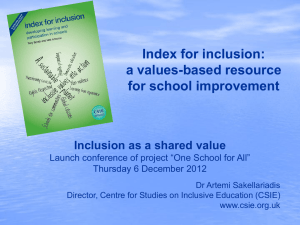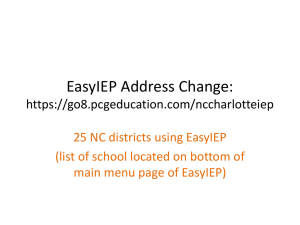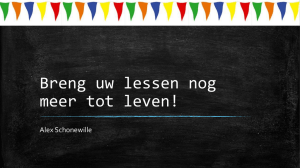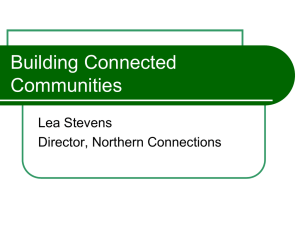working-together-improving-urban-schools
advertisement
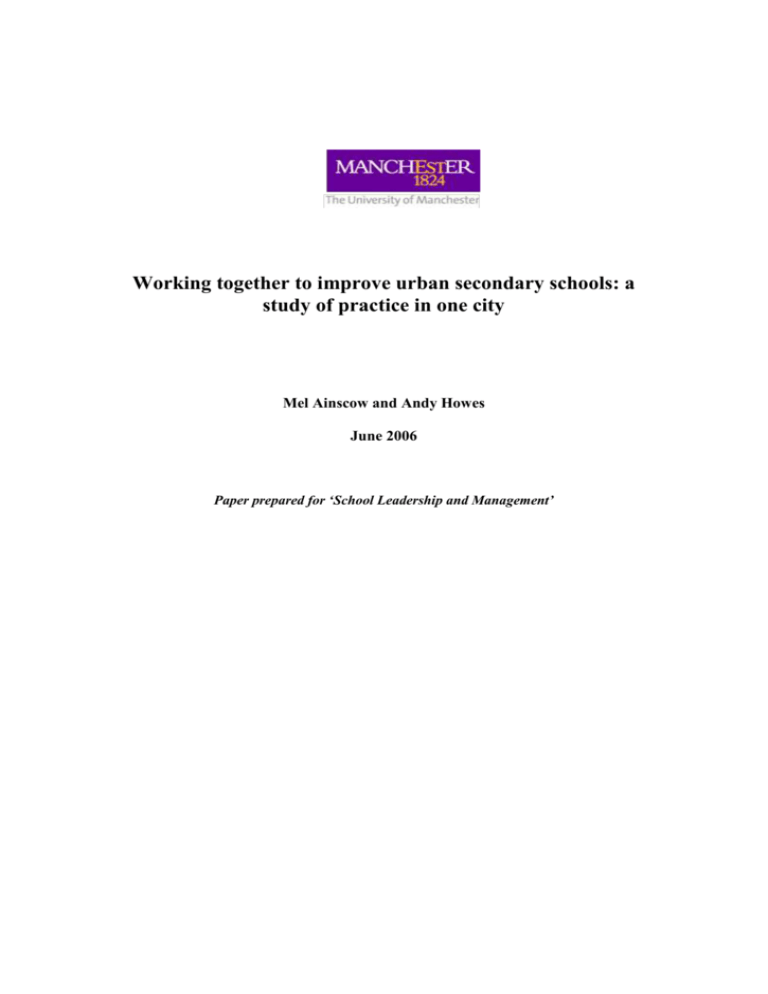
Working together to improve urban secondary schools: a study of practice in one city Mel Ainscow and Andy Howes June 2006 Paper prepared for ‘School Leadership and Management’ Working together to improve urban secondary schools: a study of practice in one city Abstract Bringing about school improvement in economically poor urban contexts remains a major challenge. In England the emphasis on competition between schools has further complicated this agenda. At the same time, there is evidence of the emergence of a new policy emphasis that involves support and challenge to school-led improvement efforts through collaboration with other schools. This paper provides an evaluative account of an attempt to use such processes of networking across all secondary schools in one city. The study suggests that schools working together can contribute to the raising of aspirations and attainment in schools that have previously had a record of low achievement, but that this is never a straightforward process – schools are complex organisations, and collaboration between them involves the orchestration of action and purpose at many levels. The paper concludes that the successful use of such approaches involves dealing with a number of challenging dilemmas, and draws out the implications for policy development. The issue of school improvement in economically poor urban contexts remains a challenge. Whilst existing research literature provides accounts of individual schools that have brought about improvements in their work despite facing challenging circumstances, there are fewer examples of progress that has been maintained beyond a relatively short period of years (Maden, 2001; Harris et al., 2003; West, Ainscow & Stanford, 2005). It is also the case that many of the examples that are described involve schools that have chosen to participate in particular improvement initiatives (Ainscow & Chapman, 2005). By their nature such schools tend to be exceptional and it is, therefore, dangerous to build policies on the basis of such experiences. During recent years schools in England have had to respond to a plethora of innovations aimed at ‘raising standards’. This is one of the reasons why a close scrutiny of what happened in the local authority we focus on in this paper is so fascinating. It shows how collaboration leading to improvement was given impetus by such external pressures. It also suggests patterns of collaboration between schools that offer promising possibilities for achieving more sustainable improvement. The paper draws on the evidence of our evaluation of networking across secondary schools in the city of ‘Bradcastle’. We start by describing the context and the strategy adopted; we then provide a summary of findings, using extracts from case studies; and we suggest an explanation for these findings in terms of the notion of 2 coping with organisational dilemmas. Finally, this leads us to draw out the implications for policy development. Changing relationships In recent years, structures and relationships within the education service in England have been fundamentally reformed. These changes have been reflected most significantly in the evolving relationships between schools and their local education authorities (LEAs). This movement, from dependency towards greater independence, has been consistently orchestrated through legislation and associated Department for Education and Skills (DfES) guidance. It was summarised in the Government’s 1997 consultation document, ‘Excellence in Schools’, which stated: ‘The role of LEAs is not to control schools, but to challenge all schools to improve and support those which need help to raise standards’. Relationships between schools have also been influenced by national policy changes, in two main ways. On the one hand, competition between schools has come to be seen as one of the keys to driving up standards. This was encouraged by the introduction of grant-maintained status for schools (now known as foundation schools) and by open enrolment, supported by the publication of league tables of school text and examination results. Greater autonomy was intended to ‘liberate’ schools from the bureaucracy of local government and establish what has been described as ‘school quasi-markets’ (Thrupp, 2001), in which effective schools would have an ‘armslength’ relationship with the LEA and, indeed, with each other. At the same time, various national initiatives, such as Excellence in Cities and the Educational Action Zones built on and developed traditions of networking and sharing between schools, focused on areas of relative social and economic disadvantage, and aimed to improve the provision of education for children and young people in those areas. Overall, the move away from a dependent relationship between LEAs and schools, to ways of working that emphasise school independence has so far failed to provide the system-wide improvement in achievement of the sort required by the community (Ainscow, Howes & Tweddle, 2006; Ainscow, Booth & Dyson, 2006). At the same time it is generally recognised that leadership for improvement efforts does need to come from within individual schools. This suggests that attempts to move schools in a more equitable direction are likely to be very demanding. They will, we suggest, require an engagement with questions of principles and purposes within the education system, and a greater emphasis on the sharing of expertise and resources. Such an approach would be consistent with what Stoker (2003) calls ‘public value management’, with its emphasis on network governance. Stoker argues that the origins of this approach can be traced to criticisms of the current emphasis on strategies drawn from private sector experience. He goes on to suggest that ‘the formulation of what constitutes public value can only be achieved through deliberation involving the key stakeholders and actions that depend on mixing in a reflexive manner a range of intervention options’. Consequently, ‘networks of deliberation and delivery’ are seen as key strategies. In the education service, this would imply the negotiation of new, inter-dependent relationships between schools, local authorities and their wider communities (Hargreaves, 2003). We are now seeing the emergence of what as been described as a new school improvement paradigm, one that places the emphasis on inter-dependence (Ainscow 3 & West, 2006). Within such an orientation attempts are made to support and challenge school-led improvement efforts through collaboration with other schools. The strategy Such arrangements require massive shifts in thinking and attitude if the potential benefits are to be achieved. In this sense, the Bradcastle strategy was particularly interesting in that it involved an attempt to create a whole-LEA approach, albeit focused only on the secondary sector. In addition, the involvement of a private partner and another LEA offered other resources that could be used to support successful implementation, whilst at the same time bringing additional complexity and, perhaps, other unknown risks. This paper draws on the findings of the project evaluation that we carried out over a period of two years on behalf of the DfES. The study involved both a formative and a summative dimension. In this way, data about the processes were used to strengthen the strategy, whilst, at the same time, constituting evidence that would help to make overall judgements as to the success of the initiative. The evidence for the study was collected through approximately thirty interviews, observations of some twenty-five meetings and collaborative events, analysis of documents and statistics relating to each school group and to the LEA. This amounted to approximately 25 days fieldwork in the city over two years. In addition a repeated survey of staff attitudes towards the project was carried out, with a total of 234 responses. Process and outcome data were then analysed and compared in order to determine conclusions as to the effectiveness of the initiative. As far as possible, findings were validated with stakeholder groups in a final round of interviews. It is important to understand something of the context of the LEA and its schools prior to the start of the project. Its introduction reflected major concerns at the DfES about levels of attainment at the secondary level in 2002. At that time there were nineteen secondary schools in the city, with three in ‘special measures’ and four seen as having ‘serious weaknesses’ following inspections, and almost half causing concern through relatively low level of GCSE results (the national examination taken by 16 year old students). Some figures suggested that as many as 25% of students were migrating out of the city at the transition to secondary school, and it was generally agreed that children of parents more motivated towards education were over-represented in this group. In addition, there were difficulties in attracting and retaining suitably qualified teachers to the city. It is impossible to be certain about exactly what relationships between LEA and schools were like at this time. However, it seems that LEA resources to support and challenge schools in raising standards were stretched. Some of those involved described a ‘culture of dependency’ on the LEA, associated with a lack of ownership of the school improvement agenda at the school level. They explained that whilst some headteachers and staff were driving their schools forward, this was against a background of widespread, relatively low expectations of city students. Others thought that the LEA could have acted more strategically in relation to the issue of admissions. Falling rolls, coupled with the increasing intake of some schools, were generating the prospect of school closures, and planning for admissions was becoming increasingly difficult. 4 The improvement strategy was described as a ‘twin-track approach’. The first track involved short term initiatives aiming to assist schools in raising standards for all students, particularly to meet the Government’s ‘floor target’ requirements within two years, in which 25% five or more A* to Cs grades in the GCSE examination was to be achieved by all schools. These responses included the production of revision guides in some subjects, booster classes for students just under the attainment targets, and rapid introduction of alternative courses taught with additional staffing in key areas. Some of these initiatives were put in place through coordination between schools. The second track was a longer-term strategy based on strengthening collaboration amongst the city’s schools. As a relatively small LEA, Bradcastle’s education department was seen to have insufficient resources to meet all the development needs of schools, without input from expertise already located in the schools. Collaboration was intended to facilitate more sharing of resources than had proved possible under earlier schemes. The implication too was that changing relationships between schools would gradually be mirrored by changing relationships with officers of the education department. With this in mind, a school improvement adviser was allocated to work with each school group. The project involved the setting up of partnership arrangements within four groups of secondary schools. These were unusual in that they were not based on geographical proximity. Rather, they were created in order to achieve groupings that would each include schools at different stages of development and with varied levels of achievement, as measured by examinations. This also meant that schools within a group were less likely to be in direct competition with one another. In addition, staff members from the partner LEA were attached to each group. Initially, those directly involved were headteachers and representative teams of staff. However, variations developed almost immediately. In one case, school leaders contributed monetary resources to a central fund, and then determined their priorities for meaningful collaboration, given the particular circumstances of the group. By contrast, another group held back, whilst in the smallest group, two headteachers effectively determined the pace of what became a developing ‘federation’ (i.e. a more formally constituted arrangement). But in all cases, it was mainly the school leaders, supported by the framework of the project, who determined what collaboration might mean in their group, and in their individual schools. Processes and outcomes The evidence we collected demonstrates how the strategy of collaboration between schools was stimulated by the project in Bradcastle, and how it led to some serious efforts and creative ways of using educational resources in order to improve effectiveness across the education system. These efforts led to significant changes in attitude and expectations amongst staff in many of the schools. In particular there were changes in their views of other schools and their staff, the nature of the challenges they faced, and in some cases, the potential for change through various practical partnerships. There was also some evidence that these processes of change were associated with improvements in student attainment in examinations. 5 However, there was considerable variation between the school groups in terms of both processes and outcomes, and it is this variation that provides much of the grist for the arguments developed in this article. Taking outcomes first, causes are hard to trace, so that there are numerous possible ways of explaining changes in student outcomes in the LEA over the period concerned. Table 1 provides an indication of attainment of successive pupil cohorts for each year from 2001 to 2004, across each of the school groups. It shows that attainment in relation to national targets increased between 2002 and 2004 in all four groups. Needless to say, these data are quite limited as a representation of change in schools, not least because no value-added data were available for the period concerned, so that no allowance for changing cohorts is made in this analysis. Nevertheless, crude as the measure is, this was the key indicator of success as far as DfES, and consequently many in the LEA and in schools, were concerned. The intention to raise raw examination results was one of the central purposes of the collaborative strategy, and as such was central to many of the activities put in place in schools across the city. The fact that the raw results rose was widely considered to be significant. Year Group A Group B Group C Group D 2001 32% 43% 33% 37% 2002 28% 31% 33% 39% 2003 37% 41% 34% 36% 2004 39% 38% 36% 41% Table 1: Percentage of pupils in each school group gaining 5 or more A*-C grade GCSE Explanations for the variation between outcomes in groups of schools are beyond the scope of our study, even in the more detailed case studies available elsewhere (Howes & Ainscow, 2006). However, it is possible to distinguish activities in terms of the intentions as to the impact on student attainments. The accounts illustrate the ‘twintrack’ approach mentioned earlier. Some activities aimed directly at attainment statistics, whilst others focused on the development of capacity in the longer term. What is even more evident is that patterns of activity varied considerably across the four groups, and the nature of the impact appeared also to be uneven. And in terms of relationships and connections, the four accounts also show how the groups developed in very different ways, and give some indication of what changed in the groups. Space precludes the inclusion of these accounts here; instead, examples of the variation in activity and relationship are presented in cameo form. Cameo 1: A focus emerges In Group A, which included several schools facing challenging circumstances and one high-performing faith school, almost a year passed before there was any significant collaborative action involving teachers. But gradually, the headteachers moved from a generalised exploration of possibilities, to a specific focus on the sharing of resources between schools. In one instance this made it possible to retain a teacher who subsequently became instrumental in facilitating school improvements activities. The presence of a LEA adviser with an eye for collaborative opportunities was significant: 6 We realised in a group meeting that we were all in dire straights in English. None of us had a head of English, with the exception of one school. The headteacher there said I’ve got an excellent teacher. The link adviser knew the teacher, and she managed and facilitated the process. It is a middle leader post, and the four schools interested share a quarter of the cost (headteacher). The additional English teacher explained that the different circumstances in the schools demanded flexible responses: I go to each school, and meet with the head of department; sometimes it gets very busy. I’m like a member of department, training newly qualified teachers, planning, doing demonstration lessons. It can be powerful, but you need to know the group. Mostly I work with groups of teachers, supporting department planning days… You get to see what is going on elsewhere, and I keep asking different people, “have you tried this?”. All five English departments have strengths, but I’m the link between them, the buffer…. My own teaching has improved so much… Typically, I’ll do a video of someone, and show it across the schools. That’s easier to arrange than mutual observation, and becomes less of a show’. Headteachers considered that such activities made a difference to staff thinking. For example: ‘My staff feel more confident, even if it’s just through the opportunity to get out and talk with colleagues in other schools, to see that the grass isn’t always greener on the other side of the fence, that other people share similar problems, and so the possibility is to come up with some solutions together’ (headteacher) Cameo 2: A federation based on trust Given strong encouragement from the project to work together, two heads in Group B, with very different experience and focus but with largely shared values, opted to manage the process so that all activities fitted into their existing development priorities. Their schools were very different. The headteacher of the voluntary aided school, set up in the eighteenth century to serve the poor, considered that collaboration with ‘a freshstart school’ (i.e. a reopened school with a new headteacher and staff) serving a less advantaged area as falling within that tradition. Both schools took some responsibility for students affected by the forthcoming closure of a third school. Gradually, joint arrangements developed around staffing, 16 to 19 curriculum options, and site supervision. In this way the schools became constituted as ‘a federation’ (i.e. a more formally designated partnership). The headteacher of the freshstart school reflected on the impact of the collaboration on her individual actions: ‘The project takes pressure off people… Knowing that you can ring someone… galvanises you to do things sometimes’ Cameo 3: A group developing an identity 7 In Group C, there was evidence of a positive attitude towards the idea of collaboration from the outset. It may well be that the ‘right mix’ of personalities among the headteachers was significant. They consistently prioritised attendance at half-termly strategy group meetings, where together they made sense of collaboration in their context, and in so doing, developed a stronger group identity. Four of the five schools agreed to pool a large proportion of the additional funds made available through the Government’s Leadership Incentive Grants (contributing £30,000 each per annum for three years) to fund collaborative processes. The other school was in special measures and was experiencing budgetary difficulties – and significantly, was given direct financial support by the group, so that they could remain as a partner. With a part of that funding, the headteachers appointed a coordinator, at deputy headteacher level, to work on deepening the collaboration. She saw this as a role that demanded considerable skill in negotiating with the group of headteachers; each having the will to collaborate, but also with their own agendas and distinctive styles. She acted as a connector, or broker, facilitating support for various teachers at the struggling school. She created links between various nationally driven initiatives that were experienced in schools as ‘innovation overload’. But it was a role full of uncertainty; going beyond what already existed, in the name of sustainable and positive change – and all this necessarily without a guiding map to follow. Unsurprisingly, then, the coordinator was faced with many personal dilemmas in respect to where she should place her effort. As the group became stronger, LEA staff began to consider which other developments and initiatives should be linked to it, and at one critical point they issued an agenda for a meeting to outline these. The headteachers reacted quickly to this proposal, informing the LEA representative that they would construct the meeting agenda, that a headteacher would chair the meeting, and that the LEA representative, whilst a welcome partner, would be a participant. The headteachers felt themselves to be exercising a powerful choice about their own future as a group. The LEA project staff considered that this incident reflected the strengthening and maturing of collaboration. Cameo 4: The search for common ground Establishing common purpose was highly problematic in Group D, and for over a year, despite the commitment of some of the headteachers, there was little sense of cohesion. Eventually, the LEA project facilitators pushed very hard for the appointment of a coordinator, whose role was to pursue the development of common interests in a practical way. Initiatives developed in respect of areas such as vocational education. However, not all headteachers demonstrated commitment to the group over the term of the project, but agencies outside the school found the group structure very useful as a basis for developing projects with the schools. In reflecting on the situation, two of the headteachers argued that the origins of the problem lay in the way that project was set up. In particular, they argued that it was imposed without reference to existing collaborative networks. Early on in the initiative we had picked up similar views from staff around the city who felt that the collaborative patterns that had previously existed within the Excellence in Cities initiative should have been used as the starting point. Later on, however, such arguments were rarely noted in our discussions in schools, suggesting, perhaps, that 8 those involved had seen evidence that the new structures were having an impact. Nevertheless, certain heads remained committed to the view that it was imposition that had created the barriers. Explaining differences The findings of our evaluation study show that school-to-school collaboration has an enormous potential for fostering system–wide improvement. Over a relatively short period, secondary schools in Bradcastle demonstrated how such arrangements can provide an effective means of solving immediate problems, such as staff shortages; how they can have a positive impact during periods of crisis, such as during the closure of a school; and, how, in the longer run, schools working together can contribute to the raising of aspirations and attainment in schools that have had a record of low achievement. These findings are, we believe, a significant contribution to school improvement knowledge, particularly in relation to system-wide reform. But there is more to learn – through attempting an explanation for the marked differences between the four collaborating groups. It is evident, even in the cameos presented here, that behind the differences in process and outcome, there are considerable tensions playing out within and between the organisations involved. An organisational perspective offers a valuable level of explanation here, and a way for example of locating individual leadership as a part of an under-determined change process (Glatter, 2006). In particular, Ogawa et al (1999) provide a powerful analysis of ‘enduring dilemmas’ of school organisation which fall into two groups: dilemmas around ownership, or what the authors term ‘social work and relations’ (around the value of professionalism, competing goals, task structures, and hierarchy); and dilemmas in relation to external influences (around persistence, boundaries, and compliance). These dilemmas provide a valuable lens with which to look at the varied patterns of collaboration that developed in Bradcastle. We suggest that the development of collaboration within each of the four groups can be explained as a result of staff in groups of schools grappling with such dilemmas together and as individuals in relation to particular contexts. The nature of these dilemmas will be understood in relation to these attempted explanations. In what follows, then, key aspects of these processes are compared and contrasted, and some explanations in terms of underlying organisational dilemmas are offered. This analysis is structured in relation to five propositions that emerged from our analysis, printed here in bold. Firstly, collaboration was part of a process whereby individual schools and groups of schools felt more of a stake in the process of school improvement. As a result, they found themselves able to act together in various combinations to tackle complex and deep-rooted problems in schools. These perceived shifts in ownership had profound effects on the relationships between the schools and the local authority. For example, a LEA officer responsible for school improvement expressed satisfaction with ‘… strong groups of schools, if there really is co-ownership of the school improvement agenda… All it does is to mean you need better arguments for what you want to do. And you get the energy of these headteachers, focused on school improvement. That’s wonderful’. 9 The issue of ownership here is suggestive of the dilemma of professionalism: as in cameo 3, there are inevitable tensions as professionals engage bureaucracies in struggles for control, but the engagement makes possible a far broader range of actions. In cameo 1, the English teacher represents one such professionally-oriented action, determined according to the professional judgements of the group of headteachers, but considerable time was needed to build trust and move beyond the bureaucratic version of collaboration. Secondly, the accounts reveal how collaborating schools contributed to a wide range of improvements, whether in terms of resources for teaching and learning, the provision and preparation of teachers and other staff, the development of alternative curricula and activities, and the measures used to determine successful teaching. The processes used had impacts which ranged between the direct and short term, to the indirect and longer term. As we have explained, a version of this distinction between short term impact and longer term sustainability was written into the original project specification, with the first part of the twopronged strategy aimed at raising achievement by any means possible, as quickly as possible. Mapping the key processes identified through the accounts in this way, suggests a useful shorthand for understanding the nature of the different changes that took place and the timescale for their impact: DIRECT IMPACT <--------------------------------------- LONGER TERM IMPACT Movement of human resources Joint advertisements/appointments Staff development activities Widening opportunities for pupils Drawing new resources Mutual challenge Re-defining quality Sharing responsibility Those activities with a more direct and immediate impact on achievement tended to be relatively easy to implement. However, the accounts also demonstrate how collaboration can help to foster more complex initiatives that may well contribute to sustainable improvements. By their nature, these activities involve processes which take longer to evolve, not least because they require the negotiation of common priorities and shared values (Fielding, 1999). In one group, for example, debates amongst headteachers became focused on the question, ‘What are our values?’ and on finding ways of making better use of difference to stimulate creativity and action; in another group, working practices focused on finding ways of reshaping parental choices around the schools involved; and in another group, the issue of priorities for development were comprehensively addressed through the development of a funding submission to sustain the collaboration. 10 The dilemmas faced here are around the nature of the goals of activities, and the extent to which school leaders aim to meet organisational needs (represented by the standards agenda, given the wider context of this project), or the needs of particular individuals within the organisation (such as those on the margins of the community of the school). However, thirdly, our evidence highlights the fact that collaboration alone own does not provide the models for development, and the accounts show that when groups of schools are planning new initiatives, materials from external sources can play an extremely significant role. Collaboration creates possibilities for working together, but does not provide much of the focus. In one group, advances in English drew on the expertise of an individual teacher, and work with local authority consultants. In another, improvement in creative arts drew on expertise external to the schools. In a third group, attempts to share good practice from within departments were seen as relatively unsuccessful, compared with the coordinated access to materials from other sources. In the fourth group, moves towards best practice in vocational education again drew on the advice of staff external to schools. Dilemmas of ‘task structure’ and ‘persistence’ are implicated in this element of the process; the extent to which external bodies legitimately dictate the formality of a task, and the extent to which it is legimate to adapt that task, is central to much of the debate over appropriate activities. In addition, and fourthly, there was an ongoing problem in relation to sources of challenge. It proved difficult for collaborating headteachers, working hard to share resources and build relationships, to address the pressing needs either of individual schools or within the system, without the assistance of outsiders to the group. The accounts demonstrate how important the role of LEA staff can be in this regard. In attempting to develop such longer term commitments, members of the school groups sometimes experienced what Johnson & Johnson (1994) see as tensions between the desire for task completion and the need for social cohesion. This dilemma over goals arises because group members engaging in task-related behaviour have to balance the individual need for good relationships with the organisational need to effectively address the task. This means that it is difficult to create a sense of mutual challenge within such collaborative working arrangements. One LEA officer explained the weakness of collaboration in these terms: ‘the primary thing is to preserve the harmony of the group’. There were cases of explicit challenge within groups, but they were often damaging to the group. So, for example, authentic peer review amongst groups of heads proved difficult to engage without some form of external structure – the dilemma around task structure resolved in this case in favour of externally-driven formality. It is not surprising then, that monitoring discussions and strategy meetings with individual headteachers continued to be the most significant opportunities to present and assist with the challenge of improvement. It strikes us that such discussions with individuals who are driving for an increase in standards will continue to be an important source of support and challenge to headteachers, whatever the nature of the collaborative structures that exist. The key difference now is that the locus of responsibility lies within schools, leaving ‘outsiders’ such as LEA staff, to use their wider experience to support and challenge those who are working together to lead improvement efforts. 11 Finally, though, collaboration between differently-performing schools (serving largely different segments of the student population, in socio-economic terms) helped reduce the polarization of the education system, to the particular benefit of students on the edges of the system and performing relatively poorly. Since collaboration was about active involvement of staff from different schools, there was plenty of interaction close to classroom practice, set within the context that schools are working in every day. As a result, staff began to see and understand each others’ issues more clearly, and were able to contribute to resolving the tensions that necessarily arise with the implementation of improvement plans. Collaboration involves working not with an abstract or distant model of ‘good practice’ but through learning directly from neighbouring schools what is possible in the context of the inevitable tensions and compromises with which school leaders and teachers have to deal. Our accounts show how headteachers with different priorities tended to emphasise different resolutions of these goal dilemmas, and how these differences could be very productive. It was also clear that where schools did work together, possibilities were sometimes created which resolved these dilemmas (albeit temporarily) in new ways. So, for example, in cameo 2 schools began to widen their curriculum offer by systematically offering places on courses to students from the other schools in the group. Implications All of this indicates that successful networking is not easy to achieve, particularly within the English context, where competition and choice continue to be the driving forces of national education policy, adding weight to the dilemmas faced by collaborating headteachers. In essence, the experience and the analysis suggests that school-to-school collaboration requires: The presence of external incentives that encourage key stake holders to explore dilemmas over their goals, in order to view collaboration as potentially being in their own interests, as well as in the interests of their competitors; Leaders in schools and in local authorities who can cope with dilemmas of professional and bureaucratic control, and centralised vs. decentralised control, through commitment to effective dialogue and serious reflection; The creation of common improvement agendas that are seen to be relevant to a wide range of stakeholders, offering a basis for an accepted resolution of the dilemma of the needs of individuals vs. those of the organisation; External help from credible consultants/advisers (from the LEA or elsewhere) who have the confidence to learn alongside their school-based partners, and who are therefore able to assist in working with these dilemmas within and between organisations; and LEA willingness and desire to support and engage with the collaborative process, so as not to destabilise effective temporary resolution of these dilemmas. It is our view that the absence of such conditions will mean that attempts to encourage schools to work together are likely to lead to time-consuming talk, which sooner or 12 later will be dropped. These conclusions are in themselves important for any national initiatives, such as the Leadership Incentive Grant and the Networked Learning Communities sponsored by the National College for School Leadership, that invest resources in the idea of schools working in partnership. The implications for leadership of these conclusions are particularly significant. Just like many other social organisations undergoing significant transformation, in schools that are under pressure to change the search is on for what Fullan (1991) describes as ‘order and correctness’. Teachers searching for correctness will inevitably experience ambiguity and a lack of understanding of the direction and purposes of the change. Thus, the search for order is a search to determine what actions to take when faced with ambiguous situations. Weick (1985) characterises schools as ‘underorganised systems’ in that although they tend to be ambiguous and disorderly there is, nevertheless, some order. Furthermore, he argues, anyone who can help to create more order within an underorganised system can bring about change. This may, in part at least, throw some light on what occurred in Bradcastle. Unusual and challenging factors, emanating as they did from both outside and inside the schools, created a sense of ambiguity. The structural arrangements introduced by some of the headteachers helped to resolve these, and, as a result, they were able to gradually drawing staff together behind broadly similar principles. As Weick explains, because ambiguity in organisations increases the extent to which action is guided by values and ideology, the values of ‘powerful people’ (i.e. those who can reduce ambiguity) affect what the organisation is and what it can become. Thus, according to Weick, those who resolve ambiguity for themselves and others can implant a new set of values in an organisation, which creates a new set of relevancies and competencies, and, in so doing, introduces a source of innovation. In this way ambiguity sets the scene for organisations to learn about themselves and their environments, allowing them to emerge from their struggles with uncertainty in a different form than when they started the confrontation. It follows, therefore, that the perspective and skills of headteachers are central to an understanding of what needs to happen in order that the potential power of collaboration can be mobilised. Their visions for their schools, their beliefs about how they can foster the learning of all of their students, and their commitment to the power of inter-dependent learning, appear to be a key influence. All of this means, of course, that replication of these processes in other schools will be difficult, particularly if those in charge are unwilling or unable to make fundamental changes in working patterns. All of this suggests that the Government’s current emphasis on ‘independent state schools’ and academies needs to be handled sensitively if it is not to further disadvantage groups of learners who already underachieving. Whilst it is true that, by and large, when schools improve it is a result of leadership from the inside, it is also the case that the wider context influences the progress of such improvement efforts, for good or ill. This is the power of what we have characterised as ‘interdependence’. It leads us to argue that, in order to improve, schools do have to become more autonomous and self-improving; at the same time, it draws our attention to the way that neighbouring schools can add value to one another’s efforts whilst at the same time supporting a more equitable approach. 13 This being the case, we suggest that in its efforts to improve education across the country, the Government would be naive to overlook the influence of what happens at the local authority level, particularly in urban contexts. Local history, interconnections between schools and established relationships are always there, even if we choose to ignore them. This being the case, we suggest that real progress towards a national education system that is geared to raising standards for all students, in all schools, requires the systematic orchestration and, sometimes, the redistribution of available resources and expertise at the local level, and that collaborative approaches are a valuable element in achieving this. References Ainscow, M. (1999) Understanding the Development of Inclusive Schools. London: Falmer Press. Ainscow, M. (2005) Developing inclusive education systems: what are the levers for change? Journal of Educational Change 6(2), 109-124 Ainscow, M., Booth, T., and Dyson, A., with Farrell, P., Frankham, J., Gallannaugh, F., Howes, A. and Smith, R. (2006) Improving Schools, Developing Inclusion. London: Routledge Ainscow, M. and Chapman, C. (2005) The challenge of sustainable school improvement. Paper presented at the International Congress of School Effectiveness and Improvement, Barcelona, January Ainscow, M., Howes, A. and Tweddle, D. (2006) Moving practice forward at the district level. In M. Ainscow and M.West (Eds.) Improving Urban Schools: Leadership and Collaboration. Open University Press Ainscow, M. and Tweddle, D. (2003) Understanding the changing role of English local education authorities in promoting inclusion. In: J. Allan (Ed.) Inclusion, Participation and Democracy: What is the Purpose? Kluwer, Academic Publishers, pp.165-177. Ainscow, M. and West, M. (Eds.) (2006) Improving Urban Schools: Leadership and Collaboration. Open University Press Ainscow, M., West, M. and Nicolaidou, M. (2005) Putting our heads together: a study of headteacher collaboration as a strategy for school improvement. In Clarke, C. (Ed.) Improving Schools in Difficult Circumstances. London: Continuum Copland, M.A. (2003) Leadership of inquiry: building and sustaining capacity for school improvement. Educational Evaluation and Policy Analysis, 25 (4), 375-395 Elmore, R.F., Peterson, P.L. and McCarthy, S.J. (1996). Restructuring in the Classroom: Teaching, Learning and School Organisation. San Francisco: Jossey-Bass. 14 Fielding, M. (1999) Radical collegiality: affirming teaching as an inclusive professional practice. Australian Educational Researcher 26 (2), 1-34 Fullan, M. (1991) The New Meaning of Educational Change. Cassell Hargreaves, D. H. (2003) Education Epidemic: Schools Through Innovation Networks. London: Demos Transforming Secondary Harris, A., Muijs, D., Chapman, C., Stoll, L. and Russ, J. (2003) Raising Attainment in Former Coalfield Areas. Sheffield: DfES Hopkins, D., Ainscow, M. and West, M. (1994) School Improvement in an Era of Change. London; Cassell Howes, A. and Ainscow, M. (2006) Collaboration with a city-wide purpose: making paths for sustainable educational improvement. In M. Ainscow and M.West (Eds.) Improveming Urban Schools: Leadership and Collaboration. Open University Press Johnson, D. W. and Johnson, R.T. (1994) Learning Together and Alone. (Boston: Allyn and Bacon). Joyce, B. and Showers, B. (1988) Student Achievement Through Staff Development. London: Longman. Lipman, P. (1997) Restructuring in context: a case study of teacher participation and the dynamics of ideology, race and power. American Educational Research Journal 34(1), 3-37 Maden, M. (2001) Success Against the Odds: Five years on. London: Routledge National Commission on Education. (1996) Success Against the Odds: Effective schools in in disadvantaged areas. London: Routledge Power, M. (1994) The Audit Explosion. London: Demos Reynolds, D., Hopkins, D., Potter, D. and Chapman, C. (2001) School Improvement for Schools facing Challenging Circumstances: A review of Research and Practice. London: DfEE Rosenholtz, S. (1989) Teachers’ Workplace: The Social Organisation of Schools. New York: Longman. Stoker, G. (2003) Public value management: a new resolution of the democracy/efficency trade off. www.ipeg.org.uk/publications.htm Strathern, M. (2000) The tyranny of transparency. British Educational Research Journal. 26 (3), 309-321 15 Thrupp, M. (2001) School quasi-markets in England and Wales: Best understood as a class strategy? Paper presented at the conference of the British Education Research Association. Leeds, September 2001 Talbert, J.E. and McLaughlin, M.W. (1994) Teacher professionalism in local school contexts. American Journal of Education 102, 120-159. Weick, K.E. (1985) Sources of order in underorganised systems: Themes in recent organisational theory. In Y.S. Lincoln (Ed.), Organisational Theory and Inquiry. Beverley Hills : Sage. West, M., Ainscow, M. and Stanford, J. (2005) Sustaining improvements in schools in challenging circumstances: a study of successful practice. School Leadership and Management 25(1), 77-93 Correspondence: Mel.Ainscow@manchester.ac.uk 16



